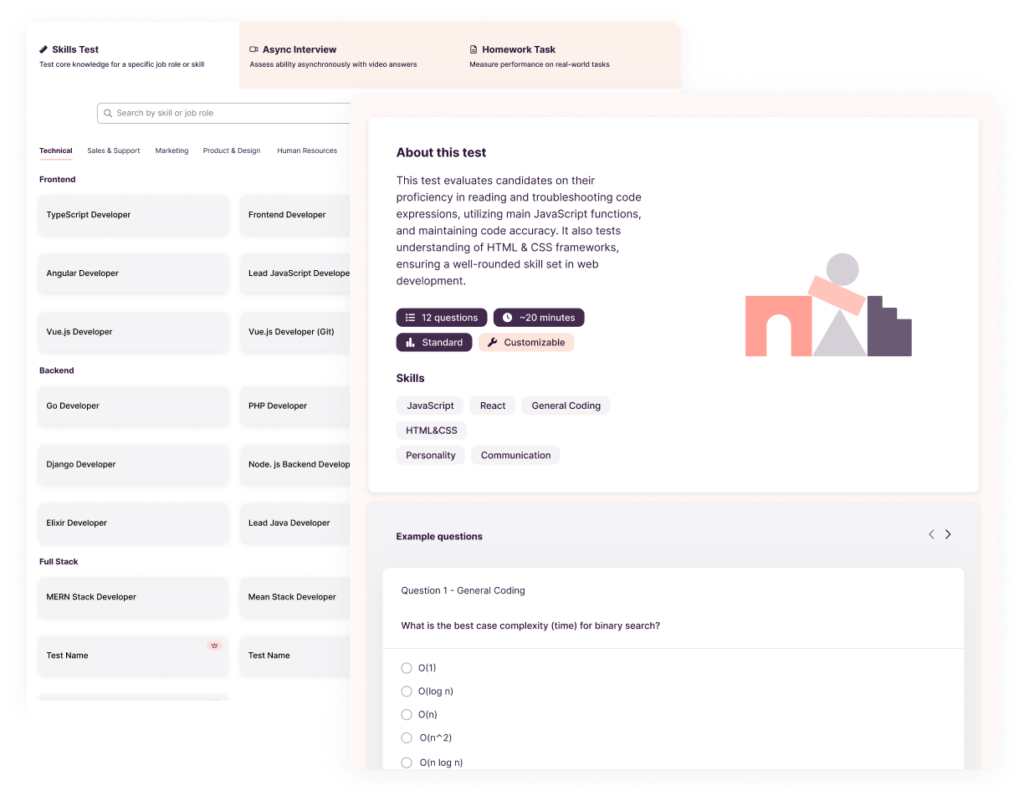Relying on traditional hiring methods to confidently choose the right candidates is becoming increasingly difficult. AI tools like ChatGPT, for example, make it easier for job candidates to adjust their resumes and cover letters with the right keywords but harder for recruiters to find the right candidates.
However, it’s not as simple as “banning” AI (what would that even look like?). The role of AI in recruitment is complex.
According to a major recent survey, although 96% of employees believe AI can help them in their current jobs, 60% say they are afraid it will automate them out of work. Similarly, while AI use is increasing, most users don’t consider the results trustworthy (and we’re aligned on that…).
To solve this problem, consider skills-based hiring instead of focusing on resumes and other easy-to-game tools or documents.
Another robust tool to help you with this approach is a skills taxonomy. While that sounds complex, we’re here to show you what it is and how to use it to streamline your hiring and ensure a better candidate fit.
TL;DR — Key Takeaways
A skills taxonomy is a classification system for organizing skills for various purposes, including organizational planning, hiring and recruitment, learning and development, and career path development.
When creating your own, it should cover these four basic elements: skills hierarchy, skill names, skill descriptions, and skills mapping.
For hiring teams, using skills taxonomies has several benefits: improved hiring accuracy, better employee development and role alignment, streamlined talent management, and strategic workforce planning.
The best information on skills taxonomies can be found across skill libraries, skill management vendors, and skills intelligence tools.
What is a skills taxonomy?
A skills taxonomy is a structured classification system that organizes skills categories based on how similar or different they are. It’s typically organized in a hierarchical way, starting with broad categories at the top and moving down to narrower categories with specific skills and competencies at the bottom.
The importance of skills taxonomy in the modern workplace is incredible, as it helps with organizational planning, hiring and recruitment, learning and development, and developing career paths. So…pretty much everything.
Elements of a skills taxonomy
A skills taxonomy is a combination of several different elements that each contribute to the overarching framework for organizing and categorizing skills in your company. To take a structured approach to hiring or employee development, it’s important to understand each element and its function if you want to organize skills in a meaningful way.
There are four key elements to creating a skills taxonomy. 👇
1. Skills hierarchy
A skills hierarchy involves organizing each skill from broad categories into specific skills and competencies. Here is an example of a skills hierarchy for a data analytics role:
1.1. Data Analysis
1.1.1. Statistical Analysis
1.1.1.1. Hypothesis Testing
1.1.1.2. Regression Analysis
1.1.2. Data Visualization
1.1.2.1. Tableau
1.1.2.2. Power BI
1.2. Machine Learning
1.2.1. Supervised Learning
1.2.1.1. Linear Regression
1.2.1.2. Decision Trees
1.2.2. Unsupervised Learning
1.2.2.1. Clustering
1.2.2.2. Dimensionality Reduction
1.3. Programming
1.3.1. Python
1.3.1.1. Pandas
1.3.1.2. NumPy
1.3.2. R
1.3.2.1. ggplot2
1.3.2.2. dplyr

A hierarchy helps you understand how employees progress through their roles and careers and how different skills are related to each other. When you understand the hierarchy well, you’ll know which technical skills someone needs to develop and how to assess them.
2. Skill names
When hiring for technical roles like data analytics, it’s important not to confuse skills like machine learning and deep learning or regression analysis and classification. However, for most non-technical hiring managers, it’s difficult to distinguish between the two.
Introduce standardized naming conventions not just for roles but also for skills in each role. This prevents confusion and helps hiring managers and recruiters easily identify:
1. If someone is a good fit and
2. Which skills need more development
3. Skill descriptions
Every time you add new skills to the skills taxonomy, you’ll need to describe them. The description should give the reader a clear understanding of what the skill includes (and doesn’t include), what the requirements are, and where those skills can be used.
When describing skills, be thorough and clear (often erring on the side of simple) so that they can be used correctly across HR teams. Because technology changes at such a rapid pace, it’s important to keep an eye on emerging skills, too.
4. Skill mapping
Skills mapping is the process of connecting different skills with the roles and responsibilities in an organization. It’s a key process for identifying skills gaps, planning how to develop employee skills, and ensuring that employees have the essential skills for working in certain roles.
This is one of the most important talent management practices, and luckily, a good skills gap analysis is an easy way to kickstart the process.
Skills ontology vs. skills taxonomy
Not to be confused, skills ontology and skills taxonomy are two distinct terms. Skills taxonomy categorizes the skills required for a certain role, while skills ontology describes the relationships between different skills.
We’ve already seen an example of a skills hierarchy for a data analytics role. Here is the skills ontology:
Python is a prerequisite for Pandas
Data Analysis includes Statistical Analysis
Tableau can be used with SQL
Machine Learning requires Programming
Linear Regression is a type of Supervised Learning
Python can be used for Data Visualization

While taxonomy is beneficial for organizing and categorizing required skills, ontology helps understand how they interact, overlap, and spot any dependencies.
5 benefits of skills taxonomy for HR and hiring managers
Building a skills taxonomy in your organization is important when taking a skills-based approach to hiring. Not only will your recruitment efforts become easier, but you’ll spot which employees need skills development faster and have an easier time finding and managing talent. Other benefits include…
1. Improved hiring accuracy
Skills taxonomies help define exactly what skills your business needs and how to evaluate them.
When you’re assessing new candidates, a pre-defined taxonomy helps to compare their skill sets with those outlined in the job requirements and job descriptions.
As a result, your chances of a bad hire are reduced significantly.
2. Enhanced employee development
With skills taxonomies, it’s much easier to identify which skills your current workforce is missing through tools such as skill gap analyses. This allows you to build a roadmap and determine which specific skills your organization is lacking for every role and department.
Use this information to create personalized career development programs that meet your organization’s individual and overarching goals.
3. Better role alignment
When you create skills taxonomies, you ensure that every employee is placed in a role that best aligns with their hard and soft skills.
This results in higher workplace productivity, increased employee engagement and satisfaction, lower turnover rates, and less money spent on hiring replacements. This is great for the business, obviously, but it’s also key to keeping employees happy long-term.
4. Streamlined talent management
Listing out all the skills for a role through a taxonomy can improve the efficiency of your entire HR department. You’ll see benefits in:
Succession planning
Internal mobility initiatives
Employee growth
Performance evaluations
Employee retention
Workforce planning
5. Strategic workforce planning
Through taxonomies and identifying skill gaps, you can future-proof your organization’s hiring. In the present moment, you can anticipate which skills you will need in the upcoming months and years.
This allows you to take a proactive approach to hiring, introduce relevant learning opportunities, train your teams, and address skills shortages well before they arise.

Where to find information on skills taxonomies
Creating a skills taxonomy is no easy feat. You’ll need reliable information from three primary sources: skill libraries, skill management vendors, and skills intelligence tools.
Skill libraries
Skill libraries offer pre-defined skills and descriptions for a variety of roles in different industries. Here are some great places to get you started:
Toggl Hire: A library of over 250 different roles with soft and hard skills tests for each role (it’s the only skills library backed by experts who help build out role descriptions and criteria for each skill—wee also add to these skills frequently based on ever-changing market trends)
O*NET Online: US-based skills library with skills, tasks, and knowledge required for a wide range of roles
Skills Framework for the Information Age (SFIA): Globally recognized skills library for IT professionals
European Skills, Competences, Qualifications and Occupations (ESCO): Multilingual classification of skills, qualifications and occupations

Visit the SFIA skills library for more IT-focused skills. The European Skills, Competencies, Qualifications, and Occupations is better if you need to test skills in different languages.
Skill management vendors
These vendors help develop, maintain, and use skills taxonomies to their full extent. They give you the tools and processes for building a taxonomy from scratch. Some examples of such vendors include:
Fuel50: Career pathing based on skills, employee engagement, and talent mobility tools
Cornerstone OnDemand: Skills and competencies frameworks, integrations with learning management systems
EdCast: Customizable skills taxonomies, AI-driven recommendations based on skills in your team
LinkedIn Learning Hub: Get info on trending skills and the right learning resources for them
Skills intelligence tools
Skills intelligence tools can help you analyze, manage, and develop employee skills in your organization. These tools use analytics and data to show what the skills landscape looks like in a company, identify emerging skills and skills gaps, and align talent development with your business’s needs.
Some examples of these tools include:
Workday Skills Cloud: Use AI to identify, manage and categorize skills in your organization
Degreed: Map and measure the skills in your team, and get tools for upskilling and reskilling
Eightfold.ai: Manage and analyze talent across the hiring lifecycle with the help of AI
Using skills taxonomies as part of skills-based hiring
If you’re keen on using a skills taxonomy to aid your skills-based hiring efforts, here are a few practical tips:
Create more accurate job requirements and job descriptions based on the skills taxonomy
Screen candidates for specific skills using assessment tools such as Toggl Hire
Run skills-based interviews to confirm if candidates have the right mix of soft and hard skills for a specific role
Make data-driven hiring decisions based on how well the candidates’ skills align with the taxonomy for the role
Use the taxonomy for custom onboarding and employee development programs
Hire for key skills with Toggl Hire
Starting to hire based on skills might feel odd at first, especially if you’ve been used to traditional hiring tools and methods for a long time. But there are plenty of new tools to help you build out a skills inventory and test every applicant based on real-world job performance.
With Toggl Hire, you can assess various skills related to a variety of job roles and introduce skills-based hiring in your entire recruitment process. You’ll have fairer, more objective hiring processes and happier, more engaged candidates and employees.
Grab your free account with Toggl Hire and get started today!
Mile is a B2B content marketer specializing in HR, martech and data analytics. Ask him about thoughts on reducing hiring bias, the role of AI in modern recruitment, or how to immediately spot red flags in a job ad.









